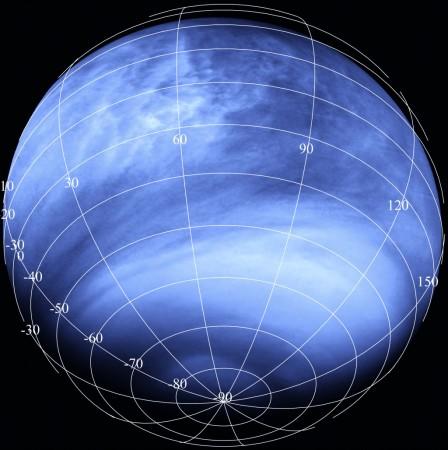
US and Russian scientists have joined hands to hunt for life on Venus with the Venera-D mission. 'D' stands for "dolgozhivushaya", which means "long-lasting" in Russian.
Also Read: Scientists discover moon is much older than we thought!
The Venera-D probe is likely to be launched in 2025. The probe will help Roscosmos and NASA look for alien life on Venus.
Venus's atmosphere comprises thick sulphuric acid clouds but also feature dark streaks that seem to absorb ultraviolet radiation. The absorption of UV radiations points to the presence of microbial life.
Russia was the first country to transmit coloured images of Venus's surface -- with the help of its Venera 13 spacecraft -- in the late 70s and early 80s.
The Venera-D probe aims at analysing Venus's atmosphere and surface. The space agencies will also vet Venus's potential for a future landing site.
Studying the planet's magnetosphere is another area researchers might explore during the mission, along with using an unmanned aerial vehicle (UAV) or a balloon for scaling atmospheric measurements over an elongated span of time.
The super rotation conundrum
The UAV's main function will be to find out reasons behind Venus's super-rotation (pace of the atmosphere in comparison to the surface). Astronomers discovered this phenomenon in the 1960s, when they spotted the presence of dark streaks in the atmosphere.
The reasons behind the streaks' absorption of UV light and why they are separate from the rest of the atmosphere remains a riddle wrapped in a mystery.
"These are questions that haven't been fully explored yet, and I'm shouting as loud as I can, saying that we need to explore them," Sanjay Limaye, an atmospheric scientist from the University of Wisconsin, Madison and a former chair of NASA's Venus Exploration Analysis Group (VEXAG), told Space.com.
Scientists in the dark
According to Limaye, the characteristics of the UV-absorbing streaks are yet to be documented. They might be crystalline in nature like ice, or a separate form of matter altogether combined in the cloud or dissolved by sulphuric acid droplets.
They are suspected to be composed of iron chloride, but astronomers are yet to find out what drove these particles 50 to 60 kilometers (31 to 37 miles) above the surface. The winds, nearer the planet's surface, are a likely culprit.
Limaye, a member of the Venera-D science definition team, said the dark clouds possibly point towards the existence of microbial life.
Microorganisms are likely to be found at high altitude in a planet's atmosphere, like they have been found in Earth's. Though the explanation sounds logical, Venus has extreme temperatures; the surface temperature is around 462 degrees Celsius (864 degrees Fahrenheit), hot enough to melt lead, and the surface pressure is 92 bar -- approximately equal to 1 km (0.6) underwater, Space.com reported.
The area, starting from 50 km (31 miles) in altitude, which spreads over 12km (7.5 miles) is likely to have varying temperatures ranging between 30 degrees C and 70 degrees C (degrees F and 158 degrees F). The region, where the dark-streaking clouds are found, has the potential to host life.
The presence of sulphuric acid in the clouds doesn't necessarily rule out the chances of life.
Earlier, Venera missions detected one-micron-long particles (equal to the width of a small bacterium) in the lower layer of the cloud. Ring-shaped polymers of eight sulphur atoms, S8 molecules, could be covering these particles. The researchers revealed that these molecules prevail in Venus's clouds and are resistant to sulphuric acid's corrosive effects.
The S8 molecules are also found to absorb UV light and re-emit it in visible wavelengths. In case, the particles discovered in the clouds are microbes, they would absorb the S8 and become resistant to the impact of sulphuric acid. The S8 molecules are assumed to be an outcome of microbial activity.
"I cannot say that there is microbial life in Venus' clouds," Limaye was reported as saying by Space.com.
"But that doesn't mean it's not there, either. The only way to learn is to go there and sample the atmosphere," he added.
As per reports, the Russian plan for the Venera-D mission originally featured balloons patrolling the atmosphere, but they are not very mobile and are unlikely to reach areas where the dark streaks exist. According to Liamye, a solar-powered UAV would be a better option to explore the clouds .
"The idea is that, with a large enough wingspan, you can generate enough power and actually fly through the atmosphere of Venus, with electric propellers, for a very long time," Limaye told Space.com.
The UAV would be filled with helium and hydrogen gas, which would keep it floating around 50km (31 miles) through the clouds in Venus's dark hemisphere. When it's day on Venus, the solar power would help increase the altitude of the spacecraft up to 60 km (37 miles).
The craft can then explore the mysterious "super-rotation" in Venus's upper atmosphere, as well as survey the clouds and UV absorbers present at different heights.
Northrop Grumman, aerospace company, has devised a Venusian UAV called Venus Atmospheric Maneuverable Platform (VAMP), which has a huge wingspan of 55 m (180 foot) engineered to function for a minimum of one year in the atmosphere.
The reports about Venera-D mission's goals will be handed to Roscosmos and NASA by the end of January 2017, the space agencies will then reveal their decision whether to work together or not. The answer can be expected later in 2017.

















